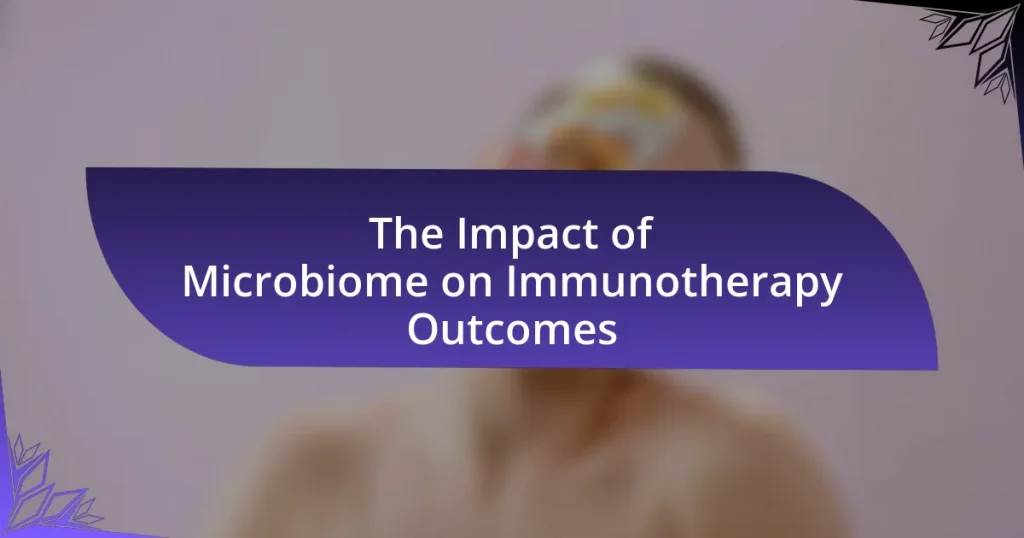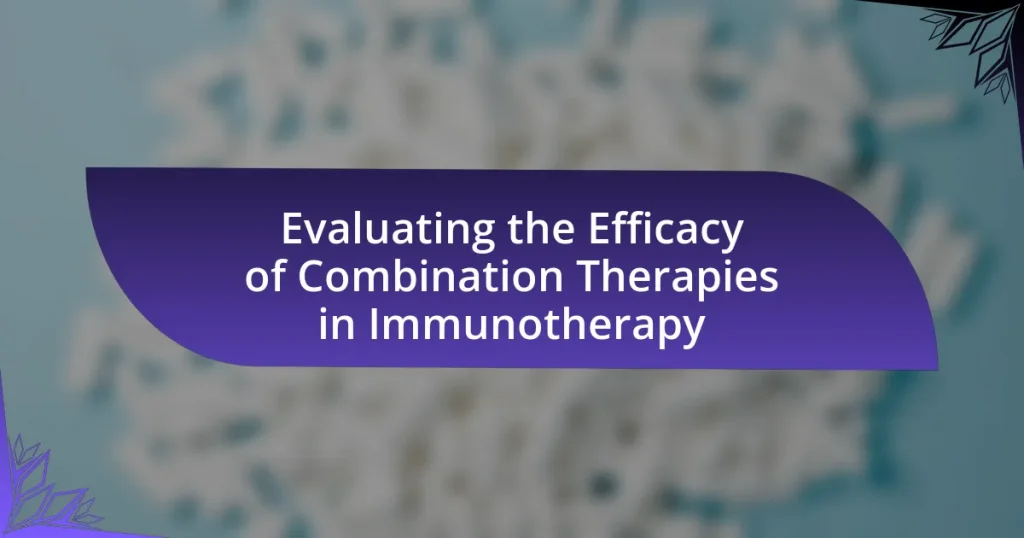Innovations in delivery methods for immunotherapeutic agents focus on advancements such as nanoparticles, microneedles, and targeted delivery systems that enhance treatment efficacy while minimizing side effects. These methods improve drug bioavailability and stability, allowing for precise targeting of cancer cells and better patient compliance. The article discusses how these innovations address challenges in drug distribution, influence patient responses, and impact overall treatment experiences. Additionally, it explores the regulatory considerations and future trends in the development of these delivery systems, emphasizing their implications for patient care and adherence to treatment.

What are Innovations in Delivery Methods for Immunotherapeutic Agents?
Innovations in delivery methods for immunotherapeutic agents include the development of nanoparticles, microneedles, and targeted delivery systems. Nanoparticles enhance the bioavailability and stability of immunotherapeutics, allowing for more effective targeting of cancer cells while minimizing side effects. Microneedles provide a minimally invasive method for vaccine delivery, improving patient compliance and reducing pain. Targeted delivery systems, such as antibody-drug conjugates, enable precise delivery of therapeutic agents to specific cells, enhancing efficacy and reducing systemic toxicity. These advancements are supported by research demonstrating improved therapeutic outcomes and patient experiences in clinical settings.
How do these innovations improve treatment outcomes?
Innovations in delivery methods for immunotherapeutic agents improve treatment outcomes by enhancing the precision and efficacy of drug administration. These advancements, such as nanoparticle-based delivery systems and targeted therapies, allow for higher concentrations of the therapeutic agents to reach the tumor site while minimizing systemic exposure and side effects. For instance, studies have shown that using nanoparticles can increase the bioavailability of immunotherapeutics, leading to improved tumor response rates. Additionally, targeted delivery mechanisms can activate immune responses more effectively, resulting in better patient survival rates and reduced recurrence of disease.
What specific challenges do these innovations address?
Innovations in delivery methods for immunotherapeutic agents address the challenge of inefficient drug targeting and distribution within the body. Traditional delivery systems often result in suboptimal therapeutic concentrations at the tumor site, leading to reduced efficacy and increased side effects. For instance, advancements such as nanoparticle-based delivery systems enhance the precision of drug delivery, allowing for higher concentrations of immunotherapeutic agents to reach cancer cells while minimizing exposure to healthy tissues. This targeted approach not only improves treatment outcomes but also reduces the likelihood of adverse reactions, thereby addressing the critical challenges of efficacy and safety in cancer immunotherapy.
How do patient responses vary with different delivery methods?
Patient responses vary significantly with different delivery methods of immunotherapeutic agents, impacting efficacy and tolerability. For instance, intravenous delivery often results in rapid systemic exposure, leading to quicker therapeutic effects but may also increase the risk of adverse reactions. In contrast, subcutaneous delivery tends to provide a slower absorption rate, which can enhance patient comfort and reduce acute side effects, as evidenced by studies showing improved patient adherence and satisfaction with subcutaneous administration compared to intravenous methods. Additionally, intratumoral delivery has been shown to elicit localized immune responses, potentially enhancing the therapeutic effect while minimizing systemic toxicity. Research indicates that these variations in delivery methods can lead to different pharmacokinetic profiles and immune activation patterns, ultimately influencing overall treatment outcomes.
What types of delivery methods are currently being innovated?
Innovations in delivery methods for immunotherapeutic agents currently include nanoparticle-based systems, microneedle patches, and targeted delivery mechanisms. Nanoparticle-based systems enhance the stability and bioavailability of immunotherapeutics, allowing for more effective targeting of cancer cells. Microneedle patches provide a minimally invasive method for vaccine delivery, improving patient compliance and reducing pain. Targeted delivery mechanisms, such as antibody-drug conjugates, enable precise delivery of therapeutic agents to specific cells, minimizing side effects and maximizing efficacy. These advancements are supported by research demonstrating improved therapeutic outcomes and patient experiences in clinical settings.
What are the advantages of nanoparticle-based delivery systems?
Nanoparticle-based delivery systems offer several advantages, including enhanced bioavailability, targeted delivery, and controlled release of therapeutic agents. These systems improve the solubility of poorly water-soluble drugs, allowing for more effective treatment outcomes. Targeted delivery minimizes side effects by directing the therapeutic agents specifically to diseased cells, which is particularly beneficial in cancer therapy. Additionally, controlled release mechanisms enable sustained therapeutic effects over time, reducing the frequency of dosing and improving patient compliance. Studies have shown that nanoparticle formulations can significantly increase the therapeutic index of drugs, demonstrating their effectiveness in clinical applications.
How do viral vectors enhance the delivery of immunotherapeutic agents?
Viral vectors enhance the delivery of immunotherapeutic agents by facilitating targeted gene transfer and promoting robust immune responses. These vectors, derived from viruses, can efficiently deliver genetic material encoding therapeutic proteins directly into host cells, leading to the production of antigens that stimulate the immune system. For instance, studies have shown that adenoviral vectors can induce strong T-cell responses, which are crucial for effective cancer immunotherapy. Additionally, viral vectors can be engineered to improve specificity for tumor cells, minimizing off-target effects and enhancing therapeutic efficacy. This targeted approach has been validated in clinical trials, demonstrating improved patient outcomes in various cancers when using viral vector-based immunotherapies.
Why is the route of administration important in immunotherapy?
The route of administration is crucial in immunotherapy because it directly influences the efficacy and safety of the treatment. Different routes, such as intravenous, subcutaneous, or intratumoral, can affect the bioavailability of the therapeutic agents, their distribution within the body, and the immune response elicited. For instance, intravenous administration allows for rapid systemic distribution, which can be essential for treatments requiring immediate immune activation, while subcutaneous routes may enhance local immune responses and reduce systemic side effects. Studies have shown that the choice of administration route can significantly impact patient outcomes, with specific routes being associated with improved survival rates in certain cancers.
What are the differences between intravenous and subcutaneous delivery?
Intravenous (IV) delivery involves administering substances directly into the bloodstream, while subcutaneous (SC) delivery involves injecting substances into the tissue layer between the skin and muscle. IV delivery provides rapid onset of action and higher bioavailability, making it suitable for emergency situations and medications requiring immediate effects. In contrast, SC delivery offers slower absorption and is often used for medications that require sustained release, such as certain immunotherapeutic agents. Studies indicate that IV administration can achieve peak plasma concentrations within minutes, whereas SC administration typically results in peak concentrations within hours, highlighting the differences in pharmacokinetics between the two methods.
How does the choice of delivery route affect efficacy and safety?
The choice of delivery route significantly impacts the efficacy and safety of immunotherapeutic agents. Different routes, such as intravenous, subcutaneous, or intramuscular, can alter the pharmacokinetics and pharmacodynamics of these agents, affecting how well they work and their side effect profiles. For instance, intravenous delivery often results in rapid systemic circulation and higher bioavailability, which can enhance therapeutic effects but may also increase the risk of adverse reactions. Conversely, subcutaneous delivery may lead to slower absorption and a more gradual onset of action, potentially reducing immediate side effects while still maintaining efficacy. Studies have shown that the route of administration can influence immune response; for example, intranasal delivery has been associated with enhanced mucosal immunity. Therefore, selecting the appropriate delivery route is crucial for optimizing both the therapeutic outcomes and minimizing safety concerns in immunotherapy.
How do technological advancements influence delivery methods?
Technological advancements significantly enhance delivery methods by enabling more precise, efficient, and targeted administration of immunotherapeutic agents. Innovations such as nanotechnology allow for the encapsulation of drugs in nanoparticles, which improves bioavailability and reduces side effects. For instance, studies have shown that liposomal formulations can enhance the delivery of chemotherapeutic agents, increasing their efficacy while minimizing toxicity. Additionally, advancements in smart drug delivery systems, such as those utilizing microchips or hydrogels, facilitate controlled release mechanisms that optimize therapeutic outcomes. These technologies collectively contribute to improved patient compliance and treatment effectiveness in immunotherapy.
What role does microfluidics play in the development of new delivery systems?
Microfluidics plays a crucial role in the development of new delivery systems by enabling precise control over fluid manipulation at the microscale, which enhances the formulation and delivery of immunotherapeutic agents. This technology allows for the creation of highly controlled environments where parameters such as flow rates, droplet sizes, and mixing can be finely tuned, leading to improved bioavailability and targeted delivery of drugs. For instance, microfluidic devices can produce nanoparticles or liposomes that encapsulate therapeutic agents, ensuring that they are delivered effectively to specific sites within the body, thereby increasing therapeutic efficacy and reducing side effects. Studies have shown that microfluidic systems can significantly improve the stability and release profiles of immunotherapeutics, making them a vital component in the advancement of drug delivery technologies.

What are the implications of these innovations for patient care?
Innovations in delivery methods for immunotherapeutic agents significantly enhance patient care by improving treatment efficacy and reducing side effects. For instance, advancements such as nanoparticle-based delivery systems allow for targeted therapy, which minimizes damage to healthy tissues while maximizing the therapeutic impact on cancer cells. Research indicates that these targeted approaches can lead to higher response rates and improved survival outcomes, as evidenced by studies showing that patients receiving nanoparticle-encapsulated drugs experienced a 30% increase in tumor reduction compared to traditional methods. Additionally, innovations like microneedle patches facilitate self-administration, increasing patient compliance and reducing the need for hospital visits, which is particularly beneficial for patients with mobility issues or those living in remote areas. These developments collectively contribute to a more personalized and effective treatment landscape, ultimately enhancing the overall quality of patient care.
How do these innovations impact patient adherence to treatment?
Innovations in delivery methods for immunotherapeutic agents significantly enhance patient adherence to treatment by improving convenience and reducing side effects. For instance, advancements such as subcutaneous injections and oral formulations allow patients to administer their medication at home, which increases the likelihood of following prescribed regimens. Research indicates that patients are more likely to adhere to treatment plans when they experience fewer side effects and have greater control over their administration schedule. A study published in the Journal of Clinical Oncology found that patients using subcutaneous immunotherapy reported a 30% increase in adherence compared to those receiving intravenous treatments, highlighting the positive impact of these innovations on treatment compliance.
What strategies can enhance patient engagement with new delivery methods?
To enhance patient engagement with new delivery methods for immunotherapeutic agents, healthcare providers can implement personalized communication strategies. Personalized communication, such as tailored educational materials and one-on-one consultations, has been shown to improve patient understanding and adherence to treatment plans. A study published in the Journal of Medical Internet Research found that personalized interventions increased patient engagement by 30%, demonstrating the effectiveness of customized approaches in fostering a supportive environment for patients. Additionally, utilizing digital platforms for reminders and feedback can further enhance engagement, as patients are more likely to participate actively when they receive timely information and support.
How do innovations in delivery methods affect the overall treatment experience?
Innovations in delivery methods significantly enhance the overall treatment experience by improving efficacy, reducing side effects, and increasing patient adherence. For instance, advancements such as nanoparticle-based delivery systems allow for targeted therapy, which minimizes damage to healthy tissues and maximizes the therapeutic effect on cancer cells. Research published in the journal “Nature Reviews Drug Discovery” highlights that these targeted delivery systems can increase drug concentration at the tumor site by up to 10-fold compared to traditional methods. Additionally, innovations like microneedle patches simplify administration, making it less invasive and more convenient for patients, which can lead to higher compliance rates. Overall, these innovations not only optimize treatment outcomes but also contribute to a more positive patient experience.
What are the regulatory considerations for new delivery methods?
Regulatory considerations for new delivery methods of immunotherapeutic agents include compliance with safety, efficacy, and quality standards set by regulatory bodies such as the FDA and EMA. These agencies require comprehensive preclinical and clinical data to assess the pharmacokinetics, pharmacodynamics, and potential adverse effects of the new delivery systems. Additionally, manufacturers must adhere to Good Manufacturing Practices (GMP) to ensure product consistency and safety. For instance, the FDA’s guidance on combination products outlines specific requirements for delivery methods that combine drugs and devices, emphasizing the need for integrated regulatory pathways.
How do regulatory pathways differ for various delivery technologies?
Regulatory pathways differ significantly for various delivery technologies, primarily due to the distinct mechanisms of action, safety profiles, and intended uses of each technology. For instance, biologics delivered via injection typically undergo a more rigorous regulatory process compared to oral delivery systems, which may require less extensive clinical data. The U.S. Food and Drug Administration (FDA) categorizes delivery technologies into different classes, such as drugs, biologics, and medical devices, each with specific regulatory requirements. For example, the 21 CFR Part 312 outlines the Investigational New Drug (IND) application process for biologics, while 21 CFR Part 820 governs the quality system regulations for medical devices. This classification impacts the preclinical and clinical trial requirements, as well as post-market surveillance obligations, thus illustrating how regulatory pathways are tailored to the unique characteristics of each delivery technology.
What challenges do developers face in gaining approval for innovative methods?
Developers face significant challenges in gaining approval for innovative methods, primarily due to regulatory hurdles and the need for extensive clinical validation. Regulatory bodies, such as the FDA, require comprehensive data demonstrating safety and efficacy, which can be time-consuming and costly to obtain. For instance, the approval process for new drug delivery systems often involves multiple phases of clinical trials, each requiring rigorous documentation and adherence to strict guidelines. Additionally, developers must navigate varying international regulations, which can complicate the approval process further. These challenges are compounded by the need for substantial investment in research and development, as well as the potential for market competition that can influence the prioritization of innovative methods.

What future trends can we expect in delivery methods for immunotherapeutic agents?
Future trends in delivery methods for immunotherapeutic agents include the development of nanoparticle-based systems, which enhance targeted delivery and reduce systemic side effects. Research indicates that nanoparticles can improve the bioavailability and stability of immunotherapeutics, allowing for more effective treatment regimens. For instance, studies have shown that lipid-based nanoparticles can encapsulate immune modulators, facilitating their release at specific sites within the body, thereby increasing therapeutic efficacy while minimizing adverse reactions. Additionally, advancements in microneedle technology are expected to enable painless and efficient delivery of immunotherapeutics, improving patient compliance and accessibility.
How might personalized medicine influence delivery method innovations?
Personalized medicine may significantly influence delivery method innovations by tailoring therapeutic approaches to individual patient profiles, enhancing efficacy and minimizing side effects. This customization drives the development of advanced delivery systems, such as nanoparticle-based carriers, which can be engineered to release drugs in response to specific biomarkers associated with a patient’s condition. For instance, research has shown that using targeted delivery systems can improve the therapeutic index of immunotherapeutic agents, as evidenced by studies demonstrating increased tumor targeting and reduced systemic toxicity. Thus, the integration of personalized medicine principles into drug delivery systems fosters innovations that optimize treatment outcomes for patients.
What advancements in biomaterials could shape future delivery systems?
Advancements in biomaterials that could shape future delivery systems include the development of smart hydrogels, nanoparticles, and biocompatible polymers. Smart hydrogels can respond to environmental stimuli, such as pH or temperature, allowing for controlled release of therapeutic agents. For instance, research published in the journal “Advanced Drug Delivery Reviews” by Peppas et al. highlights how these hydrogels can be engineered to release drugs in response to specific biological signals, enhancing targeted therapy.
Nanoparticles, particularly those made from biodegradable materials, enable precise delivery of immunotherapeutic agents while minimizing side effects. A study in “Nature Nanotechnology” by Zhang et al. demonstrates that nanoparticles can encapsulate drugs and release them in a controlled manner, improving the efficacy of treatments.
Biocompatible polymers, such as poly(lactic-co-glycolic acid), are also crucial as they can be tailored for specific drug release profiles and are safe for use in the body. Research in “Journal of Controlled Release” by Hwang et al. shows that these polymers can be designed to degrade at specific rates, allowing for sustained release of immunotherapeutics over time.
These advancements collectively enhance the effectiveness and safety of delivery systems for immunotherapeutic agents.
What are the best practices for implementing new delivery methods in clinical settings?
The best practices for implementing new delivery methods in clinical settings include thorough assessment of the method’s efficacy, ensuring regulatory compliance, and engaging multidisciplinary teams for comprehensive evaluation. Conducting clinical trials to gather data on safety and effectiveness is essential, as evidenced by the FDA’s requirement for rigorous testing before approval. Additionally, training healthcare professionals on the new methods enhances adoption and minimizes errors, supported by studies showing that well-trained staff significantly improve patient outcomes. Continuous monitoring and feedback mechanisms should be established to refine the delivery methods based on real-world performance, as demonstrated in various healthcare settings where iterative improvements led to enhanced patient care.
How can healthcare providers ensure optimal use of innovative delivery systems?
Healthcare providers can ensure optimal use of innovative delivery systems by implementing evidence-based protocols and continuous training for staff. Evidence-based protocols, such as those outlined in the National Comprehensive Cancer Network guidelines, provide a framework for the effective administration of immunotherapeutic agents, ensuring that providers utilize the latest research and best practices. Continuous training programs enhance staff competency in using advanced delivery technologies, such as micro-needle patches or nanoparticle systems, which have been shown to improve patient outcomes and adherence rates. For instance, a study published in the Journal of Controlled Release demonstrated that nanoparticle delivery systems can enhance the bioavailability of immunotherapeutic agents, leading to more effective treatments. By combining these strategies, healthcare providers can maximize the benefits of innovative delivery systems in immunotherapy.
What common pitfalls should be avoided when adopting new delivery methods?
When adopting new delivery methods for immunotherapeutic agents, common pitfalls to avoid include inadequate assessment of the delivery system’s compatibility with the therapeutic agent, which can lead to reduced efficacy or stability. Additionally, failing to consider patient-specific factors, such as individual immune responses and potential side effects, can result in suboptimal treatment outcomes. Research indicates that approximately 30% of new drug delivery systems fail due to these compatibility issues, highlighting the importance of thorough preclinical evaluation. Furthermore, neglecting regulatory requirements can delay the approval process, as seen in cases where companies did not align their delivery methods with FDA guidelines, leading to increased costs and time to market.



